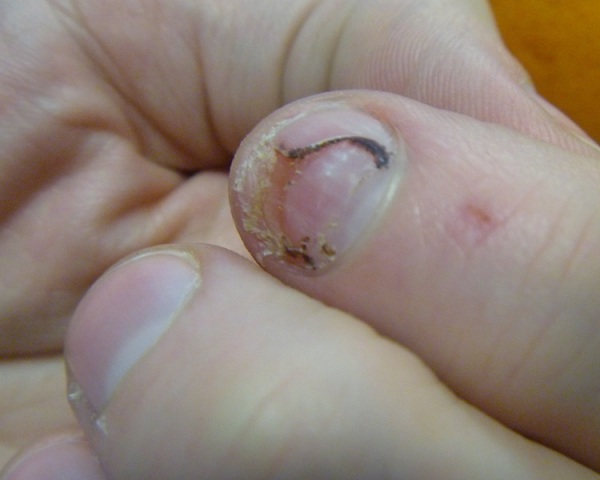Acrylic nails are worn to complement long fingers. But they have a darker side, so read on about causes, symptoms and treatments for acrylic nail fungus before beautifying your nails the artificially.
Acrylic Nail Fungus
Acrylic nails are a wonderful way to achieve stylish, beautiful nails of any length without performing the daily rituals that natural nails require. Usually people use them to cover up deformed, broken, discolored or brittle nails. Amongst all artificial nails, acrylic nails are the strongest and last longer than most other artificial nails. They are harmless if applied hygienically by professionals. However, unhygienic use of them or their overuse can lead to acrylic nail fungus. Acrylic nail fungus does not harm the acrylic nail, as fungi don’t infect artificial nails; it infects the natural nail or skin underneath or around the natural nail. If the fungus is ignored for a long time then it can cause some serious damage to your natural nails. The same fungi attacks even those who don’t wear acrylic nails, infecting their natural toenails and fingernails. Continue reading to know the causes, symptoms and treatments for acrylic nail fungus. 

Image: comedy_nose@flickr
Causes, Symptoms And Treatments For Acrylic Nail Fungus
Causes
-
Applying acrylic nails requires thickening, altering and lengthening of one’s natural nails. This can cause fungus infection between the layers. Use of nail polish on acrylic nails, produces moisture thus giving a chance to the fungi to develop.
-
One of the causes of acrylic nail fungus can be the tools used by the nail professionals. They often use the same tools for all their clients without a proper cleaning or disinfection routine. Anyone is vulnerable to the fungi present in these tools.
-
Another cause for acrylic nail fungus is lifting of artificial nails. Mostly, this is likely to happen when you are applying these nails by yourself. When these nails are lifted or not fitted properly on the natural nails, water can get in easily, providing a breeding ground for infection. Fungus develops in the presence of moisture, warmth and darkness. Thus the gap formed between the acrylic nail and the original nail is an ideal environment for the fungus to grow. Hence, poorly fitted nails are one of the main causes of acrylic nail fungus.
Symptoms:
-
The earliest sign is a yellowish or white spot under the nail tip.
-
Natural nails may seem to appear deformed.
-
They may also lose their natural shine and begin to seem discolored.
-
Your nails will become fragile, which results in breaking or crumbling.
-
The color of the skin around your natural nails may look discolored.
-
If the above symptoms are neglected and not treated on time then the nail can separate from the nail bed, a condition called onycholysis.
Treatments:
-
Even if just one finger is infected, get rid of all acrylic nails before the infection spreads or increases to the other fingers or toes. Then, cut your natural nails as short as possible. Fungus may also affect the nail bed, so clean it thoroughly on removal of the acrylic nails.
-
Consult a doctor and use a prescribed ointment.
-
Tea tree oil has the ability to kill fungal growth and eases out the infection. So apply tea tree oil on the nail and the affected skin around it.
-
White vinegar and the Apple Cider vinegar are very popular treatments. Soaking your infected nails in the solution every day for about 30 minutes really helps.
-
Listerine mouthwash works like magic for the nail fungus treatment. Daily, for 30 minutes, soak in your affected fingers in it.
-
Apply different essential oils like olive oil, lavender oil, jojoba oil, etc. that are known healers and soothers. These natural oils have the power to eradicate the fungus and also help in healing the wounds.
-
Don’t expect to see a result overnight. These treatments may take anywhere between six months to one year depending on your body. However, initial improvement can be noticed within 8 weeks. Consult your doctor immediately if no improvement is visible. In severe cases, you may have to consume oral medications to treat the fungus.
More from iloveindia.com
- Home Remedies | Ayurveda | Vastu | Yoga | Feng Shui | Tattoos | Fitness | Garden | Nutrition | Parenting | Bikes | Cars | Baby Care | Indian Weddings | Festivals | Party ideas | Horoscope 2015 | Pets | Finance | Figures of Speech | Hotels in India : Delhi | Hyderabad | Chennai | Mumbai | Kolkata | Bangalore | Ahmedabad | Jaipur
- Contact Us Careers Disclaimer Privacy Policy Advertise With Us Lifestyle Sitemap Copyright iloveindia.com. All Rights Reserved.







